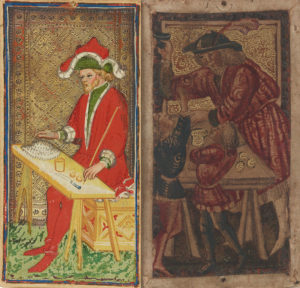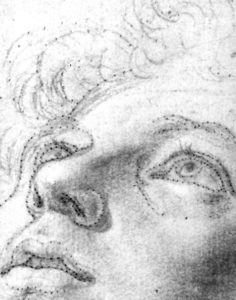
This is the second of a three-part post on the process used to paint the earliest extant tarot cards*, made in fifteenth-century northern Italy. Part I: The Studio | Part II: Preparing and designing the tarot cards | Part III: Painting and gilding the tarot cards
The cardboard for the playing cards, made by laminating paper together, would be procured from a papermaking studio. While cheap playing cards were woodblock-printed on large sheets that were colored, sometimes by stencil, then cut apart into individual cards, the high-end, hand-painted tarocchi were made individually.
First, the cardboard was cut into the correct sizes. Then each surface was prepared with several coats of gesso, a fine plaster made of gypsum mixed with animal glue. A sketch of the design was made on the satin-smooth gesso, using charcoal, with errors erased with a brush of a feather.
Plainly, the early tarocchi artists did not aim for originality. The designs of the cards had to be consistent, so players could recognize and agree on the cards’ values. An interesting aspect of many of the extant hand-painted cards is that they obviously share a design source with the Pierpont Morgan-Bergamo cards, even down to corresponding details of facial expressions and folds of clothes.
The holes at the top of many of the extant cards (for example, the “Magician” shown here) indicate the possibility that these cards were pinned to a wall or easel for copying; their preservation argues that they were not used for play. Alternatively, the person doing the cartoon for the painting may have worked from a template using the spolvero, or dust, transferring technique.

In the spolvero technique, the artist used a pin to make small holes along the outline of the original template drawing. A little bag containing powdered charcoal for black or lead powder for white, was shaken over the pricked template, with the dust filtering through the holes onto the surface to be painted. If a drawing was to be used regularly, as might have been the case with the tarocchi, several pricked transfer sheets might be made from an original drawing, or copies of the transfer sheets themselves were made.
“Pricked” transfers were passed down from master to student, and copies may have been sold or traded among different studios. As the master Cennino d’Andrea Cennini said in his circa 1437 Il Libro dell’ Arte, “bear in mind that you may copy and examine things done by other masters; that it is no shame to you.”
Once the cartoon was sketched, it was traced over in ink.
Part III: Painting and gilding the tarot cards
RENAISSANCE ITALY: GLORY, BEAUTY, GREED, WAR.
A POWERFUL HOLY WOMAN. THE INQUISITION….
A novel based on the true story of the Popess card of the tarot.
BUY: Signed by author, free shipping in US
BUY: bookshop.org | Amazon US | Amazon CA | B&N | indiebound
“Enchanting & richly historical, heart-wrenching & intoxicating.” —Stuart R. Kaplan, author Pamela Colman Smith.
“A storytelling treasure. The sights, smells, feel of Renaissance Italy seep from every pore of the story.” —Ron Andre, A Matter of Fancy
SOURCES: Cennini: The Craftsman’s Handbook. Translated by Daniel V. Thompson, Jr. New York: Dover, 1954. | “Magician” images tarotwheel.net Visconti-Sforza card: Collection Pierpont Morgan Museum & Library; D’Este card: Beinecke Library, Yale University | Verrocchio work: Collection of Staatliche Museen Preussischer Kulturbesitz, Berlin

Pingback:THE EARLY TAROT ARTISTS AT WORK | Part I: The Studio | JEAN HUETS
Pingback:Early tarot artists at work | Part III Painting and gilding